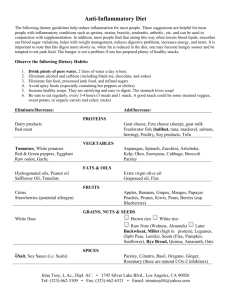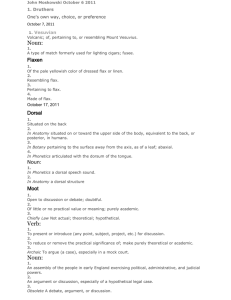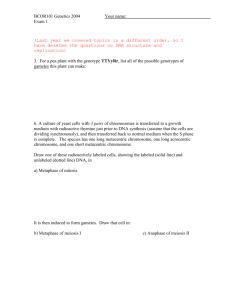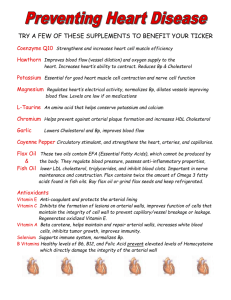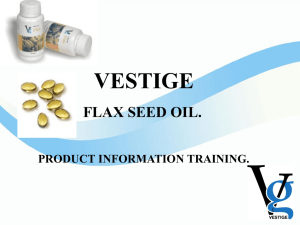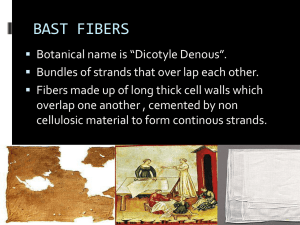research of effects of plant growth stimulants on chemical
advertisement
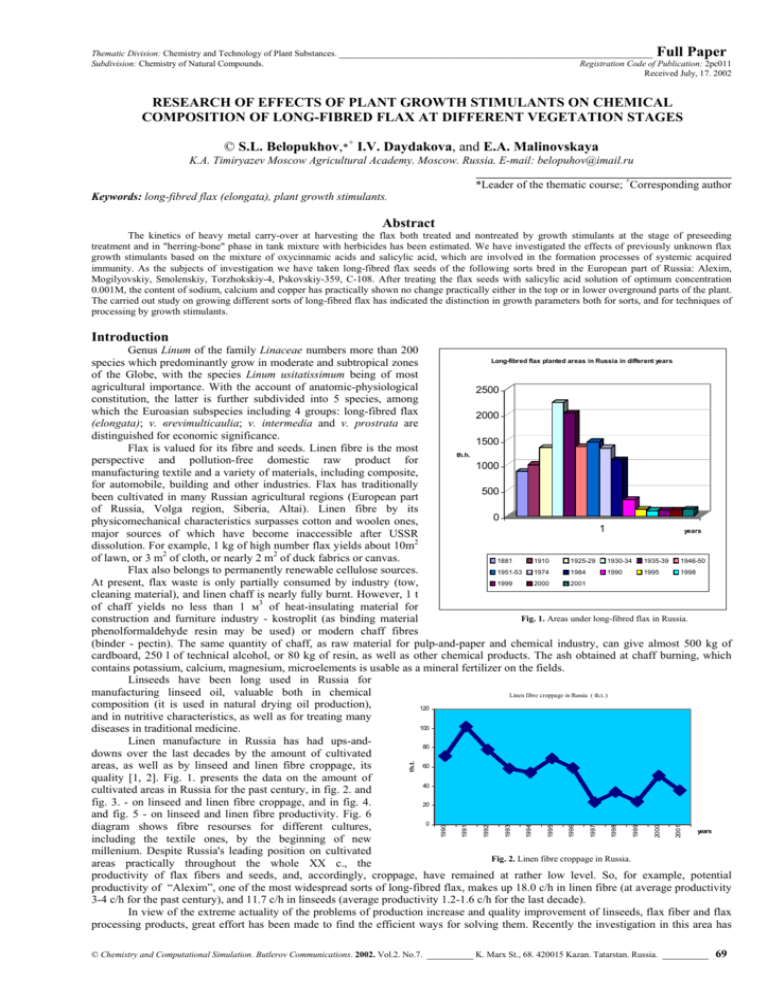
Full Paper Thematic Division: Chemistry and Technology of Plant Substances. ______________________________________________________ Subdivision: Chemistry of Natural Compounds. Registration Code of Publication: 2pc011 Received July, 17. 2002 RESEARCH OF EFFECTS OF PLANT GROWTH STIMULANTS ON CHEMICAL COMPOSITION OF LONG-FIBRED FLAX AT DIFFERENT VEGETATION STAGES © S.L. Belopukhov,*+ I.V. Daydakova, and E.A. Malinovskaya K.A. Timiryazev Moscow Agricultural Academy. Moscow. Russia. E-mail: belopuhov@imail.ru ____________________________________________ *Leader of the thematic course; +Corresponding author Keywords: long-fibred flax (elongata), plant growth stimulants. Abstract The kinetics of heavy metal carry-over at harvesting the flax both treated and nontreated by growth stimulants at the stage of preseeding treatment and in "herring-bone" phase in tank mixture with herbicides has been estimated. We have investigated the effects of previously unknown flax growth stimulants based on the mixture of oxycinnamic acids and salicylic acid, which are involved in the formation processes of systemic acquired immunity. As the subjects of investigation we have taken long-fibred flax seeds of the following sorts bred in the European part of Russia: Alexim, Mogilyovskiy, Smolenskiy, Torzhokskiy-4, Pskovskiy-359, C-108. After treating the flax seeds with salicylic acid solution of optimum concentration 0.001M, the content of sodium, calcium and copper has practically shown no change practically either in the top or in lower overground parts of the plant. The carried out study on growing different sorts of long-fibred flax has indicated the distinction in growth parameters both for sorts, and for techniques of processing by growth stimulants. Introduction © Chemistry and Computational Simulation. Butlerov Communications. 2002. Vol.2. No.7. 2001 2000 1999 1998 1997 1996 1995 1994 1993 1992 1991 1990 th.t. Genus Linum of the family Linaceae numbers more than 200 Long-fibred flax planted areas in Russia in different years species which predominantly grow in moderate and subtropical zones of the Globe, with the species Linum usitatissimum being of most agricultural importance. With the account of anatomic-physiological 2500 constitution, the latter is further subdivided into 5 species, among which the Euroasian subspecies including 4 groups: long-fibred flax 2000 (elongata); v. вrevimulticaulia; v. intermedia and v. prostrata are distinguished for economic significance. 1500 Flax is valued for its fibre and seeds. Linen fibre is the most th.h. perspective and pollution-free domestic raw product for 1000 manufacturing textile and a variety of materials, including composite, for automobile, building and other industries. Flax has traditionally 500 been cultivated in many Russian agricultural regions (European part of Russia, Volga region, Siberia, Altai). Linen fibre by its 0 physicomechanical characteristics surpasses cotton and woolen ones, 1 years major sources of which have become inaccessible after USSR 2 dissolution. For example, 1 kg of high number flax yields about 10m of lawn, or 3 m2 of cloth, or nearly 2 m2 of duck fabrics or canvas. 1881 1910 1925-29 1930-34 1935-39 1946-50 Flax also belongs to permanently renewable cellulose sources. 1951-53 1974 1984 1990 1995 1998 At present, flax waste is only partially consumed by industry (tow, 1999 2000 2001 cleaning material), and linen chaff is nearly fully burnt. However, 1 t of chaff yields no less than 1 м3 of heat-insulating material for Fig. 1. Areas under long-fibred flax in Russia. construction and furniture industry - kostroplit (as binding material phenolformaldehyde resin may be used) or modern chaff fibres (binder - pectin). The same quantity of chaff, as raw material for pulp-and-paper and chemical industry, can give almost 500 kg of cardboard, 250 l of technical alcohol, or 80 kg of resin, as well as other chemical products. The ash obtained at chaff burning, which contains potassium, calcium, magnesium, microelements is usable as a mineral fertilizer on the fields. Linseeds have been long used in Russia for manufacturing linseed oil, valuable both in chemical Linen fibre croppage in Russia ( th.t..) composition (it is used in natural drying oil production), 120 and in nutritive characteristics, as well as for treating many 100 diseases in traditional medicine. Linen manufacture in Russia has had ups-and80 downs over the last decades by the amount of cultivated 60 areas, as well as by linseed and linen fibre croppage, its quality [1, 2]. Fig. 1. presents the data on the amount of 40 cultivated areas in Russia for the past century, in fig. 2. and fig. 3. - on linseed and linen fibre croppage, and in fig. 4. 20 and fig. 5 - on linseed and linen fibre productivity. Fig. 6 0 diagram shows fibre resourses for different cultures, years including the textile ones, by the beginning of new millenium. Despite Russia's leading position on cultivated Fig. 2. Linen fibre croppage in Russia. areas practically throughout the whole XX c., the productivity of flax fibers and seeds, and, accordingly, croppage, have remained at rather low level. So, for example, potential productivity of “Alexim”, one of the most widespread sorts of long-fibred flax, makes up 18.0 c/h in linen fibre (at average productivity 3-4 c/h for the past century), and 11.7 c/h in linseeds (average productivity 1.2-1.6 c/h for the last decade). In view of the extreme actuality of the problems of production increase and quality improvement of linseeds, flax fiber and flax processing products, great effort has been made to find the efficient ways for solving them. Recently the investigation in this area has ________ K. Marx St., 68. 420015 Kazan. Tatarstan. Russia. ________ 69 Subjects and research techniques 2001 1998 1997 1996 1995 1994 1993 1992 1991 1990 Full Paper ____________________________________________________________ S.L. Belopukhov, I.V. Daydakova, and E.A. Malinovskaya been carried out in two directions: sort selection and choosing agrochemical growth conditions suitable for the particular climatic zone [3, 4]. Plant growth stimulants play an important Croppage of long-fibred flax seeds (th.t.) role not only in solving crop biomass augmentation th.t. problem, but also in growing the plants with 60 improved, from physiological and biochemical standpoints, characteristics for further industrial 50 processing [5]. Two more important practical tasks are to elaborate the quality control methods effective 40 in complex application of plant growth stimulants together with other biological preparations, pesticides 30 and microelements, as well as to study their compatibility under the conditions of preseeding seed 20 treatment and at different flax vegetation stages, and finally their effect on the yield of flax and seeds, linen 10 fibre quality. It is also known [6] that flax is capable for toxic metals selective absorption from soil, that is 0 why it would be interesting to estimate the kinetics of heavy metal carry-over at harvesting the flax both years treated and nontreated by growth stimulants at the stage of preseeding treatment and in "herring-bone" Fig. 3. Flax-seeds croppage in Russia. phase in tank mixture with herbicides. It is especially actual for the intensive technologies of crops and, in particular, long-fibred flax cultivation with different crop rotation regimes and under present-day agroecological conditions. The aim of this work is to study the effect of previously unused long-fibred flax growth stimulants based on the mixture of oxycinnamic acids and salicylic acid, which are involved in the formation processes of systemic acquired immunity [6]. The compounds under investigation also participate in the processes of lignine formation in plant cells and thus induce the synthesis of certain proteins. For this reason they should exert the influence on the specified and adjustable flax growth parameters at vegetation stage. Linen fibre productivity in Russia (c/h) As the subjects of inquiry we have taken long-fibred flax seeds of the following sorts bred in the European part of Russia: 5 Alexim, Mogilyovskiy, Smolenskiy, Torzhokskiy-4, Pskovskiy 4 359 and C-108. Plant growth is followed by agrochemical growth parameters, content of biomass inorganic components 3 and by the comparative analysis of organic components after solvent extraction. Seed germination in Petri dish is controlled in 2 sprout length and weight, experiment repetition - quadruple. 1 Seed soaking is carried out for 1 hour in growth stimulant solutions: zircon (mixture of oxycinnamic acids) and salicylic 0 acid with different concentration. Prior to "herring-bone" phase, plant growth is monitored in vegetative vessels according to the years following parameters: stalk height and diameter, flax stalk growth intensity. Revealing sodium and potassium cations is carried out by flame photometric method, calcium and copper Fig. 4. Linen fibre yield in Russia at different times cations - by atomic absorptive spectroscopy. Qualitative and quantitative analysis of organic components are performed with organic, liquid-organic extracts with the help of liquid-gas chromatography on the columns with nitrile- silicone phases (gas - carrier-helium, detector - catarometer or flame-ionization detector), and for better selectivity of mixture separation - liquid chromatography in normal-phase variant. Chromatographic peaks in qualitative analysis are identified by the indices of gas chromatography holding, in quantitative analysis inner standard method is used. 2001 1999 1997 1995 1993 1991 1985-1989 1976-1980 1966-1970 1935-1939 1925-1929 c/h 6 Results and discussion Long-fibred flax seeds productivity in Russia (c/h) 1,8 1,6 1,4 1,2 1 c/h Sprout length measurements performed for different sorts of long-fibred flax have indicated that multifold elongation occurs as early as the first day of germination period. However, there exist the distinctions in sprout growth intensity with preliminary seed soaking depending on the reagents and sorts: even in distilled water the seeds of sorts Torzhokskiy-4 and Alexim turned out to be most susceptible. As for water-treated seeds of Alexim, 96 hours later the sprouts elongated 9% of their original length; in the case of Torzhokskiy-4 - 2%. The greatest amount of information was drawn from mathematical treatment of the results obtained as linear dependences such as y = a + bx with correlation coefficient r =0.99 (table 1). 0,8 0,6 0,4 0,2 years 2001 1998 1997 1996 1995 1994 1993 1992 1991 1990 0 Fig. 5. Productivity of long-fibred flax seeds for the last decade. 70 ________________ http://chem.kstu.ru ________________ © Химия и компьютерное моделирование. Бутлеровские сообщения. 2002. T.2. №7. 69. 69-72 Coefficients b, proportional to sprout growth rate, World fibre resourses of various crops (thousand tons) are the same for sorts C-108 without soaking (I) and with preliminary soaking in distilled water, whereas for sort 18000 Torzhokskiy-4 a considerable increase of this coefficient at soaking in water is observed. Coefficients b for sorts 25000 Alexim and Smolenskiy are the same without preliminary seed soaking, the coefficient increasing at water treatment for Alexim, and on the contrary decreases for sort Smolenskiy. Coefficients a characterize germination energy at initial growth stages. Alexim sort seeds, as well cotton as those of Smolenskiy sort after preseeding treatment, 3000 have maximum germination energy. fibre crops Preparation zircon, applied in our work, is rated in 100200 long-fibred flax the last, poorly studied as to its effect on long-fibred flax, classes of biostimulators, the mechanism of which is sugar-cane similar to the processes taking place at lignine formation in plant cells. Fig. 6. World fibre resourses of various crops. We have investigated soaking effect on longfibred flax seeds of Torzhokskiy-4 sort in zircon solutions with different concentration. In zircon concentration range between 0.100 and 0.013 mg of e.d./ml, the best effect on stalk growth is reached at seed soaking in zircon solution with minimal studied concentration. In the course of plant growing there has been observed the change in mutual ratio of the heights of the plants which were subjected to preseeding treatment by zircon with different concentration. 10 days after the beginning of vegetation the stalk of the flax, the seed of which had been treated by 0.013 mg/ml solution of growth stimulant, appeared to be almost two times higher in comparison with the control experiment of flax growing without preliminary seed soaking. Plant growth data of vegetative experiments varied with zircon solution concentration at intermediate investigation stage and over 10 days are given in table 2. The data obtained in time range from 1 to 10 days were processed as mathematical dependences of the y = a . ebx + c type making it possible to estimate the peculiarities of kinetic Table. 1. Coefficients of equation y=a + bx for time dependences of long-fibred flax sprout dependences on treatment with growth stimulants. Of length (mm) without soaking (I) and with preliminary soaking in distilled water (II). interest is the comparison of kinetic curves for average sort С-108 Torzhokskiy-4 Alexim Smolenskiy zircon concentration and for the most effective one (table 3). I II I II I II I II As it is seen from table 3, preexponential factors a -5.95 -6.83 -4.80 -6.84 0.85 1.40 -0.65 1.70 are scattered within ten units, and for the most effective 0.39 0.39 0.42 0.47 0.24 0.26 0.24 0.21 zircon concentration the factor a has average value. Coefficients b, which practically do not make allowance for presumed distinction in total energy contributions to the process behavior, are the same both for growth kinetics of the flax treated in zircon with most effective concentration, and for flax growth in control experiment I without preliminary soaking. On the contrary, coefficient c has the maximum for the experiment with 0.001 mg/ml zircon concentration. In these conditions the monotonous increase of the coefficient from control experiment I without soaking in water to control experiment II with soaking in distilled water and further, with the increase of zircon concentration from 0.005 to 0.001 Table 2. Variation of stalk length (mm) of Torzhokskiy-4 sort mg/ml, is observed. As far as coefficient c corresponds to the according to the concentration of zircon solution. starting value of long-fibred flax growth at extrapolating zircon Time, control I control II Circon concentration, mg e.d../ml concentration to infinitesimal quantity, its value appears to reflect days (without (in water) 0.010 0.005 0.003 0.001 the rate increase of those processes at early flax development water) stages that are nonessential without treating by growth stimulants. 6 15.3 20.0 16.7 19.6 20.6 22.9 10 27.8 43.9 34.9 32.1 38.8 46.7 These may be the activation effect of root cell fission and the maintenance of high growth intensity owing to normalizing growth processes on additing small quantities of the compounds analogous to those appeared at lignine formation in plants. To study in more detail the dependence of plant growth parameters on zircon treatment, stalk growth and diameter were measured at small concentration of stimulant solution - 0.001 and 0.0006 mg e.d./ml (table 4). On treatment with zircon solution in the concentration of 0.001 mg e.d./ml stalk height and diameter are greater throughout vegetation period, as compared to the concentration of 0.0006 mg/ml. This fact proves the existence of the interval of growth stimulant optimum concentration in the given concentration range. The investigation of analogues dependencies of growth parameters on the treatment of long-fibred flax seeds of Smolenskiy sort by salicylic acid (SA) has shown that SA solution optimum concentration is equal to 0.001 mg/ml. In this case, 4 days later, sprout length becomes almost two times greater, than in the control experiment with seed soaking in distilled water or in salicylic Table. 3. Coefficients of dependencies y = a. ebx + c at stalk length change of Torzhokskiy-4 sort (zircon-treated seeds). acid solution with greater concentration. The investigation carried out previously [7, 8] Coefficients control I Control II Zircon concentration mg e.d./ml dealing with the definition of metal ions, first of all the toxic (without water) (water) 0.005 0.001 ones, which are the constituents of various organic a 6.98⋅10-4 9.92⋅10-4 1.04⋅10-4 8.25⋅10-4 compounds contained in long-fibred flax processing b 0.33 0.25 0.16 0.33 c 10.62 12.79 13.57 16.97 products, proved the regular linen fibre quality control with the methods of chemical and physicochemical analysis to be urgent. The analysis of the content of inorganic and organic compounds, as the characteristic of product quality, is also necessary for long-fibred flax growing at early stages, especially under the joint action of pesticides, mineral and organic fertilizers and growth stimulants. Since the definition of organic components in the extracts from linen fibre samples at different flax processing stages has revealed constant presence of several substances related to hydrocarbons and carboxylic acids С18-С30 [8, 9], such as: nonacosane, squalene, octadecanoic acid etc., the control over the compound concentration change and hence presumed change of biostimulator contribution to plant growth is fairly possible by the parameters of chromatographic holding. RESEARCH OF EFFECTS OF PLANT GROWTH STIMULANTS ON CHEMICAL COMPOSITION OF LONG-FIBRED FLAX ________________________________ © Chemistry and Computational Simulation. Butlerov Communications. 2002. Vol.2. No. 7. ______________ E-mail: info@kstu.ru _________________ 71 Full Paper ____________________________________________________________ S.L. Belopukhov, I.V. Daydakova, and E.A. Malinovskaya By growing Torzhokskiy and Alexim, long-fibred flax sorts used as the test samples, the seeds of which were treated by salicylic acid, the definition of sodium and potassium, as well as calcium and copper cations length, mm Diameter, mm concentration in overground part of plants has been carried Time. h. Сzircon=0.001 Сzircon=0.0006 Сzircon=0.001 Сzircon=0.0006 mg e.d./ml mg e.d./ml mg e.d./ml mg e.d./ml out. Flax-seeds being treated by salicylic acid with optimum 24 32.0 21.2 1.1 1.0 concentration 0.001M, the amount of sodium, calcium and 48 54.0 43.3 1.2 1.1 copper cations has been shown to be practically invariable 72 68.8 52.8 1.2 1.1 both in the top and lower overground part of plant. In this 96 77.3 60.9 1.2 1.1 case potassium content increases, on the average, by 16%. On addition of heavy metal salt solution, for example, nickel chloride, to salicylic acid solution on treating the seeds of Smolenskiy longfibred flax, the change of flax growth character at early development stages takes place: the action of 0.004M salt solution suppresses biostimulation effect, whereas the action of 0.002M solution in the first day of growth is similar to the effect of salicylic acid solution with the concentration differing from optimal. The results obtained make it possible to prognosticate the effect of growth stimulants on long-fibred flax cultivated as the crop under industrial pollution conditions. Thus, the research carried out on different sorts of long-fibred flax has indicated the distinction in growth parameters both for sorts, and for processing methods with growth stimulants. The increase of growth rate on preseeding treatment with zircon and salicylic acid solutions has justified the predicted effect of these stimulants as the agents enhancing field germinating power, productivity and flax quality. In the course of vegetation period the changes in qualitative and quantitative composition, in the ratio between the components are observed for different sorts of long-fibred flax. Treating with growth stimulants changes the rate of plant growth and chemical substance accumulation in plant biomass. The quality of linen fibre, determined by its chemical composition, can be improved by using, for example, growth stimulants having growth-stimulant and immunomodulating properties for preseeding treatment or in different vegetation phases. Table 4. Dependence of stalk length and diameter of long-fibred flax Torzhokskiy-4 on seed treatment in zircon solutions with small concentration. References [1] Statistical data on flax. Euroflax. 2002. No.2/01. Р.2-30. [2] V.V. Zhivetin, L.N. Ginzburg. Oil-bearing flax and its multipurpose application; Central Research Institute of Light Industry Complex Automation. M.: CRILICA. 2000. 96c. (Russian) [3] E.I. Pavlov, V.P. Ponazhaev. Influence of biological properties and seed quality on long-fibred flax yield. Theses of reports to the International Scientific Conference "Seed",Moscow. 14-16 December, 1999. M., Publishing house IKAR. 1999. P.152. (Russian) [4] S.L. Belopukhov, N.N. Korsun. Application of growth stimulant zircon for treating long-fibred flax cultivated in the European part of Russia. Theses of reports to the VI International Conference "Growth stimulants and plant growth in biotechnologies" 26-28 June, 2001. Moscow, Publishing house MAA. 2001. P.215. (Russian) [5] S.L. Belopukhov, N.N. Korsun, A.V. Fokin, E.V. Fokin. Influence of growth stimulants on linen fibre quality. Materials of the International Scientific Conference "Highperformance technologies in flax production and processing". 5 March, 2002. Vologda, 2002. P.225-226. (Russian) [6] G.S. Muromtsev, D.I. Chkannikov, O.N. Kulaeva, K.Z. Gamburg. Foundations of chemical control over plant growth and productivity. M.: Publishing house "Agropromizdat". 1987. P.20. [7] V.V. Zhivetin, O.M. Ol'shanskaja, A.V. Artemov. About the use of flax. J. Ecology and industry of Russia. March 2002. P.42-45. (Russian) [8] I.V. Dajdakova, S.L. Belopukhov. Application of liquid-gas and liquid chromatography at different stages of long-fibred flax growth. Materials of the International Scientific Conference "High-performance technologies in flax production and processing", 5 March, 2002. Vologda, CRILICA. 2002. P.224-225. (Russian) 72 ________________ http://chem.kstu.ru ________________ © Химия и компьютерное моделирование. Бутлеровские сообщения. 2002. T.2. №7. 69.

